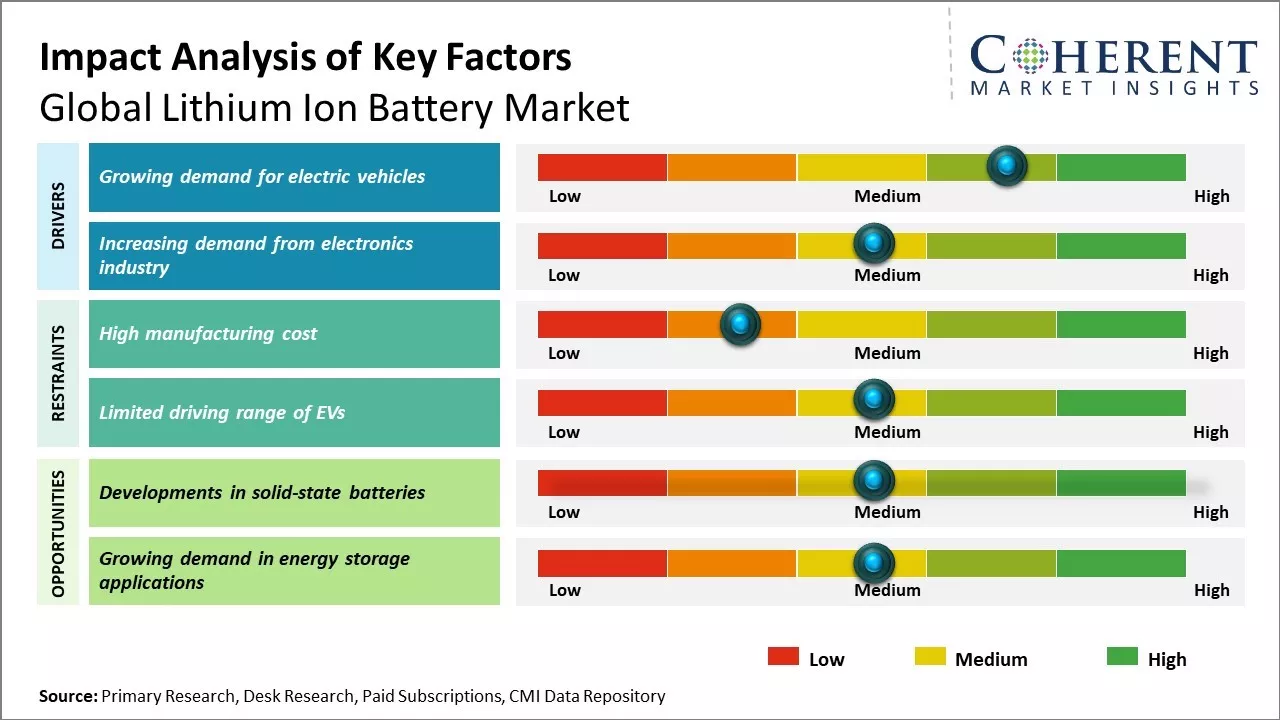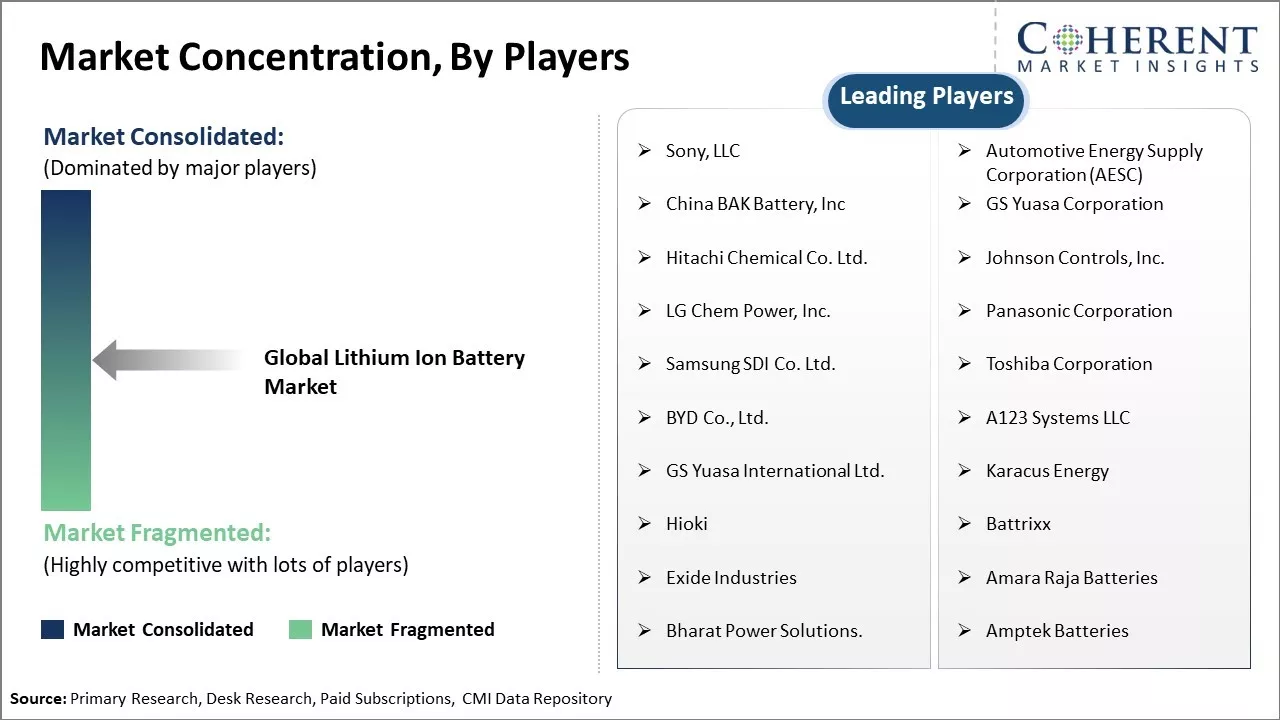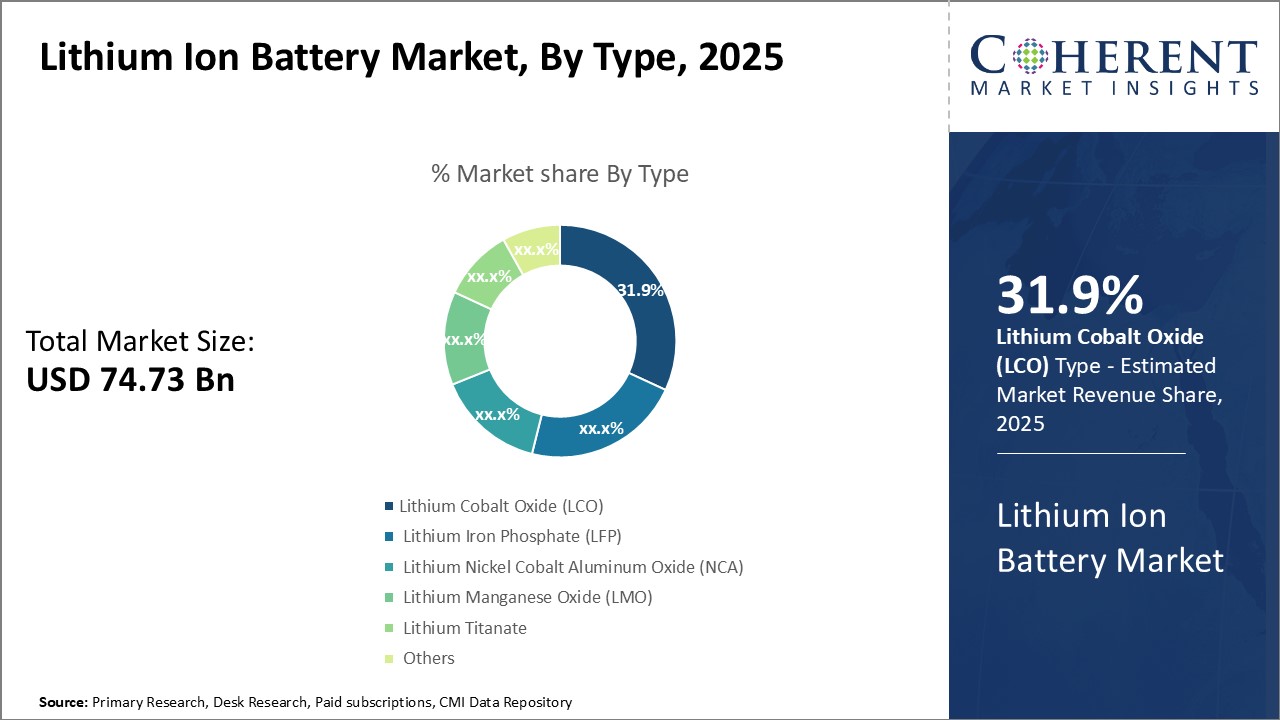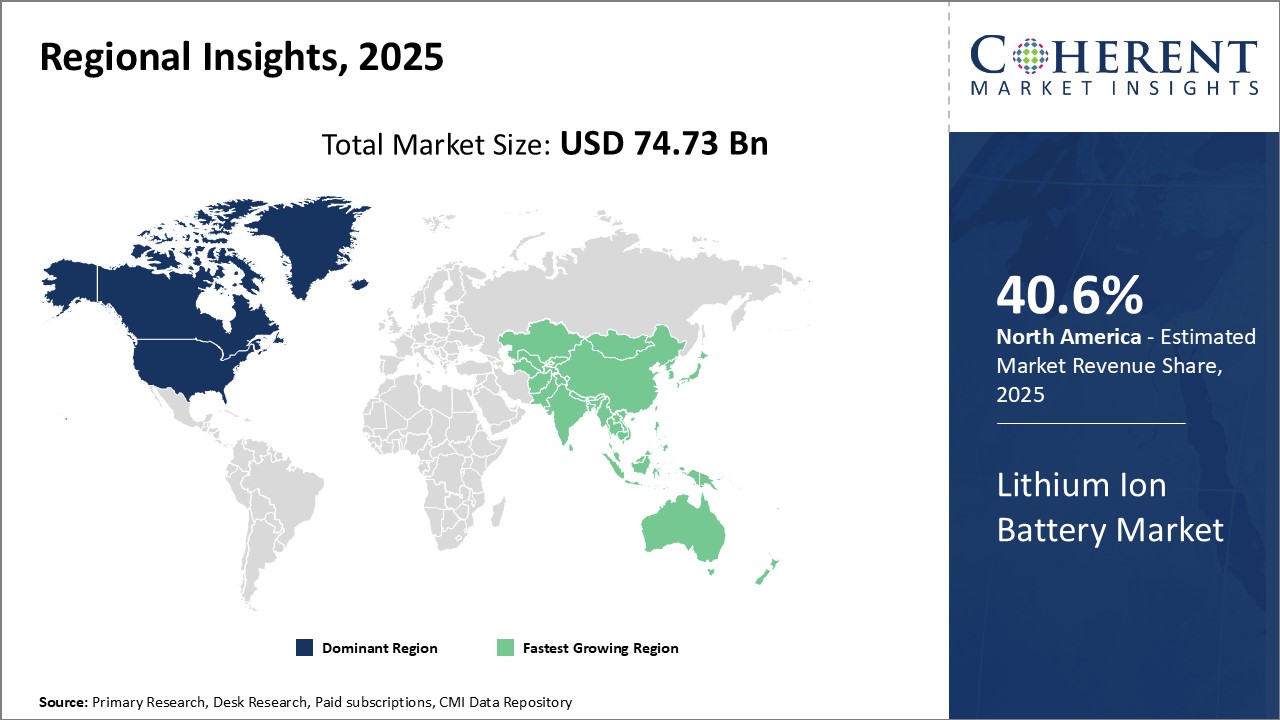The lithium ion battery market is estimated to be valued at USD 74.73 Bn in 2025 and is expected to reach USD 228.47 Bn by 2032, exhibiting a compound annual growth rate (CAGR) of 17.3% from 2025 to 2032.

Discover market dynamics shaping the industry: Request sample copy
The lithium ion battery market is expected to witness significant growth over the forecast period owing to increasing demand from electric vehicles and grid energy storage systems. Lithium-ion batteries are widely used in numerous applications such as consumer electronics, electric vehicles, energy storage, and others. Rapid urbanization and growing concerns regarding environmental pollution have increased the demand for EVs over the recent years. Favorable government policies and regulations supporting the use of electric vehicles along with declining battery prices are expected to drive the EV adoption worldwide. This growing EV demand has led OEMs to significantly invest in developing efficient and cost-effective lithium-ion batteries with higher driving range. Furthermore, the incorporation of lithium-ion batteries in grid energy storage systems to support increasing renewable energy integration will continue driving the market growth over the next decade.
Growing demand for electric vehicles
The rising demand for electric vehicles across the globe is a major driver behind the growth of the lithium ion battery market. With growing awareness about the environmental issues caused by conventional fuel-based automobiles, EV adoption has been surging in recent years. Automakers are heavily investing in electric and hybrid vehicles to transition to cleaner technologies. Stringent emission norms in various countries are also encouraging the shift towards EVs. Customers find EVs appealing due to lower running cost, instant torque generation, and tax benefits offered by governments.
Tesla has revolutionized the passenger EV segment with stylish vehicles that are packed with cutting-edge technology and convenience features. Other luxury automakers like BMW, Mercedes, and Audi are fast catching up with their premium electric offerings. Meanwhile, mass market leaders such as Nissan, Hyundai, and Kia have launched very competitive electric hatchbacks and sedans that are driving the EV adoption further. Commercial vehicles are also transitioning to electric power with new electric models being launched by companies catering to e-buses, e-trucks, and last-mile delivery vehicles. As battery costs come down rapidly, EVs are getting closer to achieving price parity with conventional vehicles. All these factors are resulting in a rocketing demand for lithium-ion batteries from the automotive industry. New battery gigafactories are also coming up across key markets to meet this growing appetite for lithium-ion cells.

Get actionable strategies to beat competition: Request sample copy
Increasing demand from electronics industry
Another major driver is the rising consumption of lithium-ion batteries from the field of consumer electronics. Right from smartphones to laptops, almost every essential electronic gadget nowadays uses rechargeable lithium-ion batteries. Improving disposable incomes in developing economies are allowing millions of people to upgrade to the latest electronic devices each year. Smartphones have become ubiquitous with over 6 billion users globally. New models are getting launched consistently with more powerful processors, dazzling displays, and advanced cameras - all of which demand higher battery capacities.
Portable devices like tablets, wearables, and wireless headphones have also become very popular. The exponential growth of online streaming services is driving up the need for large batteries in devices that support long hours of uninterrupted video playback. With 5G networks beginning their rollout, the data consumption on mobile is predicted to boom manifold in the coming years. This will further increase the battery lifetime requirements from mobile devices.
Key Takeaways from Analyst:
The lithium ion battery market continues to experience strong growth driven by increasing demand from electric vehicles and electronics devices. EVs in particular are expected to be a major driver of battery demand as vehicle electrification gains momentum worldwide led by regulations pushing for lower vehicle emissions.
On the supply side, battery materials costs especially that of cathode materials appear to have peaked and are expected to decline over the coming years on the back of new mining capacities and reuse of materials from retired EV batteries. This should help lower battery pack prices and make EVs more affordable and accessible. Competition among battery manufacturers is also intense which will keep battery prices competitive. However, demand continues to outstrip supply posing restraints. Additionally, fluctuating raw material costs and supply chain disruptions from global events remain a challenge for battery makers to address.
Overall, the lithium ion market is poised for significant growth opportunities through the decade. Success in lowering battery costs and extending driving ranges of EVs will be key to boosting wider consumer acceptance.
Market Challenges: High manufacturing cost
The high manufacturing cost of lithium-ion batteries remains a key challenge restricting the growth of the global lithium-ion battery market. Producing lithium-ion batteries involves several intricate processes requiring advanced machinery and technologies. The raw materials used such as lithium, cobalt, nickel, and manganese needed to manufacture battery cells and packs are expensive. Additionally, as batteries need to meet stringent safety and quality standards, producers have to invest heavily in research and development to enhance battery chemistry and manufacture next-generation batteries.
Market Opportunities: Developments in solid-state batteries
Developments in solid-state batteries have the potential to be a major opportunity in the global lithium-ion battery market. Solid-state batteries use a solid electrolyte instead of the liquid or polymer electrolyte found in conventional lithium-ion batteries. This offers several advantages over current battery technology. Using a solid electrolyte makes the batteries less flammable, improving safety. It also allows for batteries that can be up to three times as energy dense as liquid lithium-ion batteries. Higher energy density means solid-state batteries will be able to power devices and electric vehicles further on a single charge.

Discover high revenue pocket segments and roadmap to it: Request sample copy
Insights by Type: Emerging Demand for High Energy Density Drives the Adoption of Lithium Cobalt Oxide Batteries
The Lithium Cobalt Oxide (LCO) segment is expected to hold 31.9% share of the lithium ion battery market in 2025, due to their high energy density. The push for devices and vehicles to offer longer battery life on a single charge has intensified the demand for battery chemistries capable of delivering more energy per unit weight or volume.
Compared to other lithium battery types, LCO batteries have an excellent energy density, which makes them ideal for applications requiring a high energy output in a compact package. Major technology companies rely on LCO in portable consumer devices like smartphones and laptops where space is limited but power needs are high. Their energy density allows fitting a large battery capacity into tight product designs without compromising portability or aesthetics.
While LCO batteries offer unparalleled energy storage, recent years have seen significant gains in rival chemistries like lithium iron phosphate (LFP) and lithium nickel manganese cobalt oxide (NMC). However, LCO retains an edge in applications with very stringent power-to-weight expectations that have not been met yet by alternative chemistries. Drones, virtual reality headsets, and other devices pushing the boundaries of miniaturization continue preferring LCO for its unmatched energy density in small form factors. Automakers also use LCO batteries extensively in electric vehicles seeking to maximize driving range per charge within size constraints. Going forward, incremental density improvements by manufacturers through material and cell engineering will help LCO batteries defend their market leader position as demand follows the trajectory of portable electronics and electric mobility.
Insights by Application: Surging Electric Vehicle Adoption Drives the Automotive Segment Growth
Within the various applications of lithium-ion batteries, the automotive segment is expected to hold 41.6% of the market share in 2025. This is attributed to the exponential rise in electric vehicles worldwide as governments implement policies and consumers embrace ecological transportation solutions. Electric vehicles run entirely on a battery-powered electric motor and require lithium-ion battery packs often larger than 100kWh to provide adequate driving range between charges. Their proliferation is enabling the mass-market potential of EVs to be realized. Major automakers are aggressively expanding EV lineups in response to regulatory push for lower vehicle emissions as well as evolving buyer preferences.
Countries incentivizing EV adoption through consumption subsidies and infrastructure investments are seeing dramatic usage growth. Developing a domestic EV and battery manufacturing industry is a priority for economic competitiveness and energy security of nations. Meanwhile, lithium-ion cell suppliers are ushering in new generations of high-density, longer-life batteries customized for automotive power and thermal requirements. This virtuous cycle of EV market expansion, policy support, manufacturing investments, and technology advancement is propelling the automotive segment to become critical for the overall lithium-ion battery industry landscape. As more automakers electrify model ranges and introduce affordable long-range EVs, lithium-ion battery demand from vehicle manufacturers will continue expanding at a compounded rate.

Need a Different Region or Segment? Customize now
North America has established itself as the dominant regional market for lithium ion batteries. The region is expected to account for over 40.6% of the market share in 2025, due to a strong industrial presence of key players in this space. The U.S. is home to major battery manufacturers and OEMs like Tesla, Panasonic, LG Chem, etc. who have set up large production facilities to cater to the growing demand. Furthermore, the automotive industry in the U.S. and Canada is adopting electric vehicles at a significant rate which is contributing to the lithium ion battery demand. Various state governments are providing subsidies and tax benefits to promote local manufacturing of batteries and electric vehicles.
The Asia Pacific region, specifically China, is emerging as the fastest growing market for lithium ion batteries globally. Chinese companies like CATL and BYD have rapidly expanded their production capacity over the last few years and are now among the top battery suppliers in the world. Taiwan and South Korea are also emerging as major hubs for battery components manufacturing. The electric vehicle market in China is growing exponentially with strong government support through directives and incentives for local manufacturers. This has created a massive demand for batteries which is being fulfilled by the abundant local supply chain. India and Southeast Asian countries are also witnessing rise in adoption of EVs and energy storage products which will contribute to the Asia Pacific market growth.
Lithium Ion Battery Market Report Coverage
| Report Coverage | Details | ||
|---|---|---|---|
| Base Year: | 2024 | Market Size in 2025: | USD 74.73 Bn |
| Historical Data for: | 2020 To 2024 | Forecast Period: | 2025 To 2032 |
| Forecast Period 2025 to 2032 CAGR: | 17.3% | 2032 Value Projection: | USD 228.47 Bn |
| Geographies covered: |
|
||
| Segments covered: |
|
||
| Companies covered: |
Sony, LLC, Automotive Energy Supply Corporation (AESC), China BAK Battery, Inc, GS Yuasa Corporation, Hitachi Chemical Co. Ltd., Johnson Controls, Inc., LG Chem Power, Inc., Panasonic Corporation, Samsung SDI Co. Ltd., Toshiba Corporation, BYD Co., Ltd., A123 Systems LLC, GS Yuasa International Ltd., Karacus Energy , Hioki, Battrixx , Exide Industries, Amara Raja Batteries, Bharat Power Solutions., and Amptek Batteries |
||
| Growth Drivers: |
|
||
| Restraints & Challenges: |
|
||
Uncover macros and micros vetted on 75+ parameters: Get instant access to report
*Definition: The lithium ion battery market consists of companies involved in the manufacturing, distribution and sale of rechargeable lithium-ion battery packs and cells. Lithium-ion batteries are used to power a variety of portable electronic devices such as laptops, tablets, smartphones, power tools, and electric vehicles. They have a high energy density, low self-discharge and no memory effect compared to other battery technologies. The lithium ion battery market has shown strong growth in recent years due to the proliferation of mobile devices and push for more energy efficient transportation.
Share
Share
About Author
Yash Doshi is a Senior Management Consultant. He has 12+ years of experience in conducting research and handling consulting projects across verticals in APAC, EMEA, and the Americas.
He brings strong acumen in helping chemical companies navigate complex challenges and identify growth opportunities. He has deep expertise across the chemicals value chain, including commodity, specialty and fine chemicals, plastics and polymers, and petrochemicals. Yash is a sought-after speaker at industry conferences and contributes to various publications on topics related commodity, specialty and fine chemicals, plastics and polymers, and petrochemicals.
Missing comfort of reading report in your local language? Find your preferred language :
Transform your Strategy with Exclusive Trending Reports :
Frequently Asked Questions
Joining thousands of companies around the world committed to making the Excellent Business Solutions.
View All Our Clients
US Reciprocal Tax Impact Analysis On Lithium Ion Battery Market
Stay updated on tariff changes with expert insights and timely information